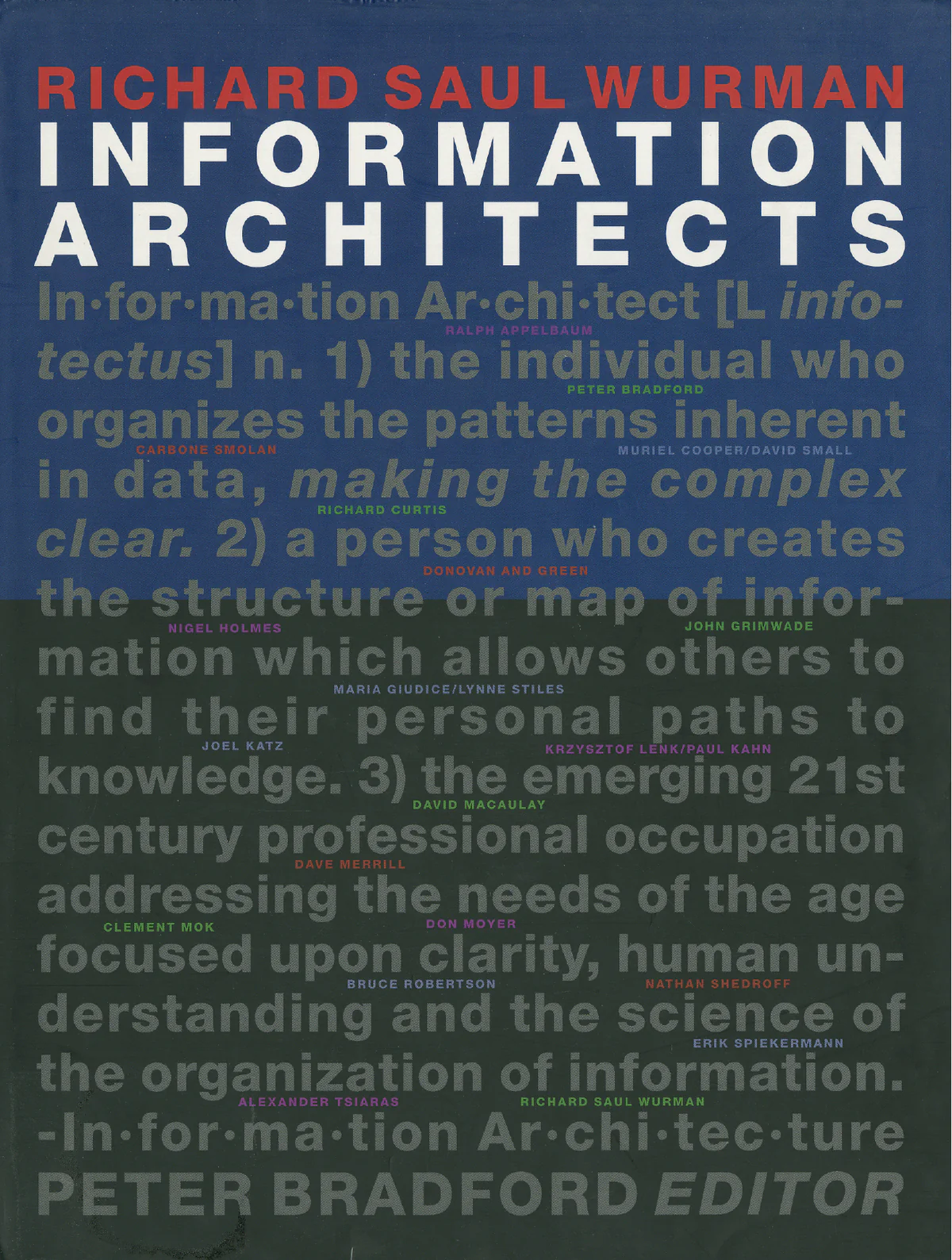# Information Architecture First Principles
! [ rw-book-cover] (https://jarango.com/assets/images/2024/09/strata.jpg)
URL: https://jarango.com/2024/09/01/information-architecture-first-principles/
Author: Jorge Arango

## AI-Generated Summary
Information architecture (IA) is a discipline that helps people understand complex information systems by organizing and structuring data clearly. Key principles of IA emphasize that people learn through context, patterns, and minimizing cognitive load while pursuing specific goals. By focusing on these principles, designers can create more effective environments that guide users to actionable information.
## Highlights
> while some folks adhered to the Wurman definition, we became evangelists of the LIS (library and information science) school of information architecture. ([View Highlight](https://read.readwise.io/read/01j6t1xc6jcngh1wss50kh511v))
>  ([View Highlight](https://read.readwise.io/read/01j6t1yn3rnrywx6d224zwr4y2))
#### People only understand things relative to things they already understand
#### This is how we learn: by relating new ideas to ideas we already understand. Mental models grow by accretion. There are no ‘intuitive’ information structures, only learnable ones; our job is building scaffoldings that allow people to find their way to knowledge.
People only understand things in context
> This principle is related to the first. I understood it implicitly, but only came to fully appreciate it via Andrew Hinton’s wonderful book [*Understanding Context*](https://www.oreilly.com/library/view/understanding-context/9781449326531/). The gist is that *where* we encounter concepts changes how we understand them. Consider the verb ‘save’: it means different things in a bank, a church, and a computer. Same word, completely different meanings depending on the context. ([View Highlight](https://read.readwise.io/read/01j6t36qke45vz8p13gzmxvxr0))
> The ground isn’t just a stage or background to the figure: it’s integral to what you experience as the ‘figure.’ ([View Highlight](https://read.readwise.io/read/01j6t38tt6ne85pk0dxa41qy34))
> The choices in the menu are experienced within a context — but they also create the context. Figure/ground, yin/yang, heads/tails – none exist as independent entities; they’re only understood in relation to a context they help create. ([View Highlight](https://read.readwise.io/read/01j6t39q4y7wwqc5b2gxp6z04j))
#### People rely on patterns and consistency
> Your mind has redundancy mechanisms built in. You fill in the gaps – as long as you understand the elements that create the gaps. Environments that present consistent and recognizable patterns are easier to understand and navigate. They provide clues for your mind to fill in the rest. ([View Highlight](https://read.readwise.io/read/01j6t3fw6svxtw3asp31dpjtjd))
#### People seek to minimize cognitive load
> People prefer to interact with things they find easy to use — i.e., the ones that don’t require a lot of cognitive effort. This requires understanding both the system’s content and the mental models of people interacting with the system. Understanding both requires research. ([View Highlight](https://read.readwise.io/read/01j6t3m86ze8fnwhkvs7scz30t))
#### People have varying levels of expertise and familiarity
#### People are goal-oriented
#### People often don’t know what they’re looking for
> In [*The design of browsing and berrypicking techniques for the online search interface*](https://pages.gseis.ucla.edu/faculty/bates/articles/berrypicking.pdf), Marcia Bates offered berrypicking as a metaphor for how people find information. Rather than go directly to the right search term, people meander through different systems picking up ‘berries’ (terms) that help them refine their search. In the process, they learn the language they need to be conversant in the space. They ask better questions, and consequently, make better searches. A virtuous cycle ensues. ([View Highlight](https://read.readwise.io/read/01j6t3z79e1r2k4wk6x8x7by3y))
> This idea has a couple of important implications for design. First, the environment should include concepts users recognize as ‘berries.’ Second, (some) environments must provide different types of berries — different pathways — to accommodate users with different levels of expertise. (See the concept of [progressive disclosure](https://en.wikipedia.org/wiki/Progressive_disclosure).) ([View Highlight](https://read.readwise.io/read/01j6t4013jgm2hcc7y9a0p0aqs))
#### Information is more useful when it’s actionable
> Which is to say, IA doesn’t merely inform people in the abstract. The semantic structures users encounter aren’t merely “good to know”; they allow them to do things. So it helps to think of options and labels as having degrees of ‘actionability.’ Some are obviously actionable; others are head-scratchers. Does the user know what to do with a particular option? Do they understand how it’s relevant to what they’re trying to do? Is it in language they understand? Can they successfully predict the effects of choosing one option over another? ([View Highlight](https://read.readwise.io/read/01j6t45xzznjtytvgkwb8p0adx))
#### Toward a Different Framing for Design
> In his 1996 book, Wurman defined an information architect as
> > 1. the individual who organizes the patterns inherent in data, making the complex clear.
> > 2. a person who creates the structure or map of information which allows others to find their personal path to knowledge.
> > 3. the emerging 21st century professional occupation addressing the needs of the age focused upon clarity, human understanding and the science of the organization of information ([View Highlight](https://read.readwise.io/read/01j6t48easrwmkgrp5fes5dzrq))
> The dominant metaphor today casts them as ‘products.’ It’s useful insofar as it offers an understandable framing for business leaders, but it’s certainly not the only one possible. Some digital systems are more like places than like products. A bank’s mobile app isn’t a product in the sense that a checking account is a product. Instead, the app is the place where people purchase and use the company’s products, get help when needed, interact with other customers, and more — much like they did in physical branches. ([View Highlight](https://read.readwise.io/read/01j6t4bdpebsab2kytbky4w4bp))